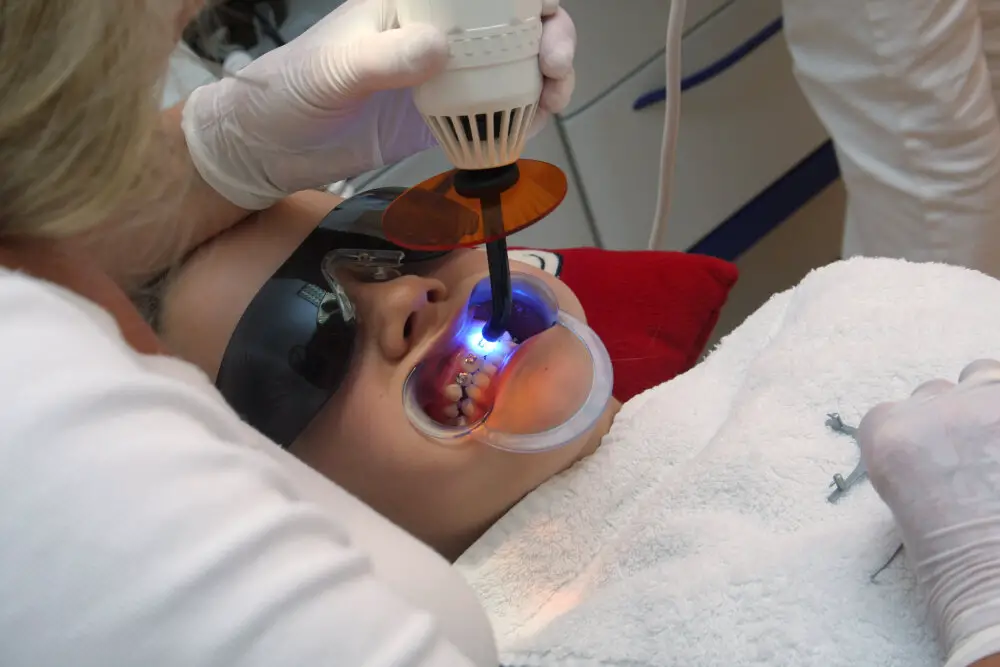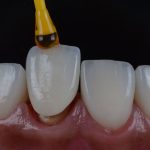Closing the Gap: Expert Tips on How to Fix Gap Between Teeth

A beautiful smile is one of the most sought-after physical attributes, and having a gap between your teeth can be a source of insecurity for many. It is a common condition that affects people of all ages, and it can be caused by a variety of factors, including genetics, habits, and dental problems. Fortunately, there are many effective ways to fix a gap between teeth, ranging from orthodontic treatments to cosmetic procedures. In this article, we will provide expert tips and advice on how to close the gap and achieve the smile you’ve always wanted. One of the most common solutions for fixing a gap between teeth is braces. Braces are a type of orthodontic treatment that uses wires and brackets to gradually shift teeth into the desired position. While braces can be a bit uncomfortable and require a longer treatment time than some other options, they are generally the most effective way to fix a gap between teeth. In addition to traditional metal braces, there are also clear braces and invisible aligners available, which can be more discreet and comfortable for some patients. If you’re considering braces to close your gap, it’s important to consult with an orthodontist to determine the best course of treatment for your specific needs.
A gap between teeth, also known as diastema, is a space that forms between teeth, typically the front two teeth. This gap can be caused by a variety of factors, including genetics, abnormal jaw growth, gum disease, or a habit of thumb sucking. While some people embrace their gap as a unique feature, others may feel self-conscious about it and seek ways to close the gap. Fortunately, there are several cosmetic dental procedures available to fix the gap between teeth, from braces to veneers to bonding. It’s important to consult with a dental professional to determine the best course of action for your individual needs.
A gap between teeth, also known as diastema, can cause significant aesthetic concern for some individuals. However, beyond the cosmetic aspect, there are also functional reasons to consider closing the gap. A gap between teeth can make it difficult to chew food properly, leading to digestive problems. It can also cause speech difficulties, as air can escape through the gap when trying to pronounce certain words. In addition, gaps can increase the risk of gum disease and tooth decay as food particles become trapped in the space. By addressing the gap, individuals can improve their overall oral health and enhance their self-confidence, leading to a happier and healthier life.
Causes of Gap Between Teeth

The gap between teeth, also known as diastema, can be caused by several factors. One of the most common causes is genetics. Some people are simply born with a gap between their teeth due to the size of their teeth and the size of their jaw. In some cases, the gap may be wider than normal, causing aesthetic concerns. In other cases, the gap may be smaller, but still noticeable. Another cause of diastema is the habit of thumb sucking or pacifier use during childhood. This can cause the teeth to shift and create a gap that persists into adulthood. Additionally, gum disease or periodontal disease can cause the teeth to shift, leading to gaps between them. Other factors that can contribute to diastema include changes in the size of the teeth or jaw due to injury or wear and tear, as well as missing teeth. There are several options available for individuals who want to close the gap between their teeth. One of the most common options is orthodontic treatment, such as braces or clear aligners. Braces use brackets and wires to gradually shift the teeth into the desired position, while clear aligners use a series of removable trays to achieve the same result. Another option is bonding, which involves applying tooth-colored resin to the teeth to close the gap. This method is less invasive than orthodontic treatment, but may not be as effective for larger gaps. Veneers are another popular option, which involve placing thin shells over the front of the teeth to improve their appearance. Ultimately, the best course of action will depend on the individual’s specific needs and goals. Consulting with a dental professional can help determine the most suitable treatment plan for closing the gap between teeth.
Genetics plays a significant role in determining the size and shape of our teeth and jaw. For instance, individuals with smaller jaws may have overcrowded or misaligned teeth, resulting in gaps between teeth. Inherited traits can also impact the development and growth of the bones and tissues that support our teeth, leading to various dental concerns. However, while genetics may contribute to dental problems, there are several methods to fix the gaps between teeth, including orthodontic treatments, veneers, and cosmetic dentistry. By consulting with a dental professional, individuals can explore their options and determine the most suitable approach to enhance their smile and oral health.
Tongue thrusting, also known as reverse swallowing, is a common habit that can contribute to the development or worsening of gaps between teeth. This occurs when the tongue presses forward against the front teeth during swallowing or at rest. Over time, this can cause the teeth to shift or become misaligned, leading to gaps or other orthodontic issues. Tongue thrusting can be caused by various factors, including allergies, thumb-sucking, or improper tongue positioning. It is important to identify and address tongue thrusting early on to prevent further damage and ensure proper dental alignment. In some cases, orthodontic treatment or speech therapy may be necessary to correct the issue.
Thumb sucking is a common habit among young children that can lead to dental problems, including the development of gaps between teeth. The constant pressure from the thumb can cause the teeth to shift and create spaces, which can cause issues with speech and eating. It is important to address thumb sucking early on to prevent the formation of gaps and other dental issues. Parents can encourage their children to stop thumb sucking by offering positive reinforcement, providing distractions, and using thumb guards or bitter-tasting nail polish. In severe cases, a dentist or orthodontist may recommend additional interventions, such as braces or a habit-breaking appliance, to correct the gap and prevent further damage to the teeth.
Gum disease, also known as periodontal disease, is a common condition that affects the gums and the surrounding tissues. It is caused by the buildup of plaque on the teeth, which can lead to inflammation and infection. Some of the common symptoms of gum disease include bleeding gums, bad breath, and receding gums. If left untreated, gum disease can lead to tooth loss and other serious complications. Fortunately, there are several ways to prevent and treat gum disease, including regular brushing and flossing, professional cleanings, and lifestyle changes such as quitting smoking and eating a healthy diet. By taking care of your oral health, you can prevent gum disease and enjoy a healthy, beautiful smile.
Trauma, defined as a deeply distressing or disturbing experience, can have a significant impact on a person’s life. While many people may associate trauma with physical injuries, it can also refer to emotional or psychological wounds that can be just as debilitating. Trauma can manifest itself in a variety of ways, including anxiety, depression, and post-traumatic stress disorder. For those who have experienced trauma, seeking professional help can be critical in the healing process. In addition, practicing self-care techniques, such as exercise and mindfulness, can help to reduce the impact of trauma on daily life.
Treatment Options for Gap Between Teeth

A gap between teeth can be a cosmetic concern that affects a person’s confidence and self-esteem. Fortunately, there are several treatment options available to close the gap and create a more attractive smile. One of the most common options is dental bonding, which involves applying a tooth-colored resin to the teeth and shaping it to fill in the gap. This is a quick and painless procedure that can be completed in a single visit to the dentist. However, bonding is not as durable as other treatments and may need to be replaced over time. Another option is orthodontic treatment, such as braces or clear aligners. This involves gradually shifting the teeth into the correct position to close the gap. While this treatment takes longer than bonding, it provides a more permanent solution and can also correct other dental issues, such as overcrowding or bite problems. Additionally, orthodontic treatment can improve overall oral health by making it easier to clean the teeth and reducing the risk of gum disease and tooth decay. Ultimately, the best treatment option will depend on the individual’s specific needs and preferences, as well as the advice of their dentist or orthodontist.
Orthodontic treatment, such as braces or aligners, can be an effective solution for closing gaps between teeth. Braces consist of metal brackets and wires that are attached to the teeth, gently shifting them into the desired position. Aligners, on the other hand, are clear plastic trays that are custom-made to fit over the teeth and gradually move them into alignment. Both options require regular adjustments and maintenance, but can ultimately provide a straighter, more aesthetically pleasing smile. Additionally, correcting gaps between teeth can also improve overall oral health by reducing the risk of gum disease and tooth decay. It is important to consult with an orthodontist to determine which treatment option is best suited for individual needs and goals.
Dental bonding is a cosmetic dental procedure that is used to fix a variety of dental issues, including gaps between teeth. It involves the application of a tooth-colored composite resin material to the surface of the tooth, which is then bonded to the tooth using a special light. Dental bonding is a quick and painless procedure that can be completed in a single visit to the dentist. It is a great option for those who want to close a gap between their teeth, as it can be used to build up the tooth and fill in the space. Dental bonding is also an affordable option compared to other cosmetic dental procedures, making it a popular choice for those on a budget.
Veneers are a popular and effective solution for fixing gaps between teeth. These thin, custom-made shells are made of porcelain or composite material and are bonded to the front surface of the teeth. Veneers can not only close gaps but also cover up stains, chips, and other imperfections, giving you a brighter, more even smile. The process involves removing a small amount of enamel from the teeth to make room for the veneers and taking impressions to ensure a precise fit. Veneers are a long-lasting and natural-looking option for those looking to improve their smile. However, they do require some maintenance, such as regular brushing, flossing, and dental check-ups to ensure their longevity. Overall, veneers are a great option for those looking to close gaps and achieve a more confident smile.
Crowns are one of the most effective ways to fix gaps between teeth. A crown is a tooth-shaped cap that is placed over a damaged or decaying tooth. It is made of materials like porcelain, ceramic, or metal, and is cemented to the tooth. Crowns not only fill in the gap but also enhance the appearance of the tooth. They are custom-made to match the size, shape, and color of the surrounding teeth, giving a natural look. Crowns are a long-term solution for teeth gaps, and with proper care, they can last for many years. While they may be more expensive than other options, they are worth the investment for those looking for a permanent solution to their gap problem.
Dental implants are a popular and effective solution for closing gaps between teeth. They are essentially artificial tooth roots that are placed into the jawbone, providing a stable base for a replacement tooth or bridge. Implants are a great option for those who have lost a tooth or have gaps between teeth, as they look and feel like natural teeth and can last a lifetime with proper care. The procedure for getting dental implants involves multiple appointments over a period of several months, but the end result is a beautiful, functional smile that can boost your confidence and overall oral health. It’s important to consult with a qualified dental professional to determine if implants are the right solution for your specific needs.
Expert Tips for Preventing Gap Between Teeth

A gap between teeth is a common dental issue that can affect anyone, and it can be caused by a variety of reasons. While some people may embrace their unique smile, others may feel self-conscious about their gap and seek ways to close it. Luckily, there are several expert tips that can help prevent gaps between teeth from forming in the first place. One of the best ways to prevent gaps between teeth is to maintain good oral hygiene. Brushing twice a day and flossing once a day can help keep teeth healthy and prevent tooth decay, which can lead to gaps. Additionally, regular dental checkups can help identify any potential issues and prevent them from becoming more serious. Another way to prevent gaps between teeth is to avoid habits that can damage teeth, such as biting on hard objects or using teeth as tools. This can weaken teeth and increase the risk of gaps forming. Additionally, wearing a mouthguard while playing sports or engaging in other physical activities can help prevent dental injuries that can lead to gaps. Finally, eating a healthy diet that is rich in calcium and other essential nutrients can help keep teeth strong and healthy, which can help prevent gaps from forming. By following these expert tips, individuals can take proactive steps to prevent gaps between teeth and maintain a healthy, beautiful smile. In conclusion, preventing gaps between teeth requires a combination of good oral hygiene practices, healthy habits, and regular dental checkups. By taking these steps, individuals can reduce their risk of developing gaps between teeth and maintain a healthy, attractive smile. However, if a gap does develop, it is important to seek the advice of a dental professional to determine the best course of treatment. With the right guidance and care, it is possible to close a gap between teeth and achieve a smile that is both healthy and beautiful.
Good oral hygiene is essential for maintaining healthy teeth and gums. It involves brushing your teeth twice a day with fluoride toothpaste, flossing daily, and using mouthwash to kill bacteria that cause bad breath. Regular dental check-ups are also crucial to prevent and detect any potential dental issues. Additionally, avoiding sugary and acidic foods can help prevent tooth decay and erosion. By practicing good oral hygiene, you can not only keep your teeth and gums healthy but also prevent the development of gaps between your teeth.
Avoiding habits that can cause gaps between teeth is crucial to maintaining good oral health. One of the main causes of gaps is poor oral hygiene, which can lead to gum disease and tooth decay. It’s important to brush and floss regularly, and to see a dentist for cleanings and check-ups. Another habit to avoid is thumb sucking, which can cause teeth to shift and create gaps. Chewing on pencils or other objects can also cause gaps, as can tongue thrusting or incorrect swallowing patterns. By being mindful of these habits and taking steps to prevent them, you can help ensure that your teeth stay healthy and gap-free.
Regular dental checkups are crucial for maintaining good oral health and fixing gaps between teeth. During these appointments, your dentist will examine your teeth and gums for any signs of decay, infection, or other issues that can cause gaps between teeth. They may also recommend treatments such as braces, aligners, or veneers to help close the gap. Additionally, regular cleanings can remove plaque and tartar buildup that can contribute to gaps and other dental problems. By scheduling regular dental checkups, you can ensure that your teeth and gums stay healthy and beautiful, and that any gaps are appropriately addressed.
Cost and Maintenance of Gap Between Teeth Treatment

Closing the gap between teeth is a common cosmetic dental procedure that can improve the appearance of a person’s smile. However, the cost and maintenance of gap between teeth treatment should be taken into consideration before deciding on this procedure. The cost of gap between teeth treatment can vary depending on the severity of the gap and the type of treatment chosen. Traditional braces can cost anywhere from $3,000 to $7,000 while clear aligners such as Invisalign can cost between $3,500 to $8,000. Dental bonding and veneers are also options that can range from $300 to $2,500 per tooth. Maintenance is also an important factor to consider with gap between teeth treatment. Traditional braces require frequent adjustments and proper oral hygiene to prevent tooth decay and gum disease. Clear aligners must be worn for at least 22 hours per day and removed for eating and cleaning. Dental bonding and veneers can last for several years but may require replacement if they become chipped or damaged. It is important to discuss the maintenance requirements and any potential risks with a dental professional before deciding on a gap between teeth treatment.
When it comes to closing the gap between teeth, there are several treatment options available, each with its own cost. One of the most affordable options is dental bonding, which involves applying a tooth-colored resin to the teeth to fill in the gap. This procedure typically costs between $300 to $600 per tooth. Another option is dental veneers, which are thin shells placed over the front of the teeth. This is a more expensive option, with costs ranging from $800 to $2,000 per tooth. Orthodontic treatments, such as braces or clear aligners, can also be used to close gaps, but they are typically the most expensive option, with costs ranging from $3,000 to $8,000. It is important to discuss your options and budget with your dentist to determine the best course of action for your individual needs.
Maintaining the results of closing the gap between teeth requires proper dental hygiene. For orthodontic treatment, such as braces or aligners, it is essential to follow the orthodontist’s instructions regarding oral care and cleaning. Regular visits to the orthodontist for adjustments are also necessary to ensure the treatment progresses as planned. Dental bonding and veneers may require occasional replacement or touch-ups, but daily brushing and flossing, as well as avoiding hard or sticky foods, can help prolong their lifespan. Teeth whitening treatments may require touch-ups every few months, and maintaining good oral hygiene habits can also help prolong the results. Overall, regular dental check-ups and proper oral care at home are crucial for maintaining the results of any gap-closing treatment.
Insurance coverage for gap between teeth treatment varies depending on the type of insurance plan and the severity of the gap. Many dental insurance plans may cover orthodontic treatments such as braces or clear aligners, which can effectively close gaps between teeth. However, cosmetic treatments such as dental bonding or veneers may not be covered by insurance, as they are considered elective procedures. It is important to check with your insurance provider to see what coverage is available for gap between teeth treatment. Additionally, some dentists may offer financing options or payment plans to make treatment more affordable for patients without insurance coverage.
Having a gap between teeth might be a cosmetic concern for some people, but it can also lead to functional issues such as difficulty in biting and chewing food. Furthermore, gaps can cause misalignment in the jaw and teeth, leading to potential issues with speech and even gum disease. Neglecting to fix gaps between teeth can also lead to a lack of confidence in one’s appearance. Fortunately, there are various treatment options available, such as orthodontic treatment, dental bonding, veneers, and implants, that can effectively close gaps and improve both the functionality and aesthetics of one’s smile.
Closing the gap between teeth is a cosmetic concern that can affect your self-esteem and confidence. While there are various treatment options available, it is crucial to consult with a dental professional to create a personalized treatment plan. A dental professional can examine your teeth and gums, assess the severity of the gap, and recommend the best treatment options for your specific needs. Depending on the severity of the gap, treatment options can range from orthodontic treatments such as braces or clear aligners to cosmetic procedures such as veneers or bonding. By consulting with a dental professional, you can ensure that you receive the most effective and personalized treatment plan to achieve the desired results.
Conclusion

In conclusion, fixing the gap between teeth is a common cosmetic concern that can be addressed through various methods. It is important to consult with a dental professional to determine the best option for your specific case. From orthodontic treatment to cosmetic bonding, there are solutions available to help close the gap and achieve a confident, beautiful smile. Additionally, maintaining good oral hygiene and regular dental check-ups can help prevent future gaps from forming. Embracing your unique smile is also important, as our imperfections make us who we are. However, if the gap between your teeth is causing discomfort or self-consciousness, know that there are options available to help you feel confident in your smile. With the help of expert tips and guidance, closing the gap between your teeth can be a successful and rewarding journey.




